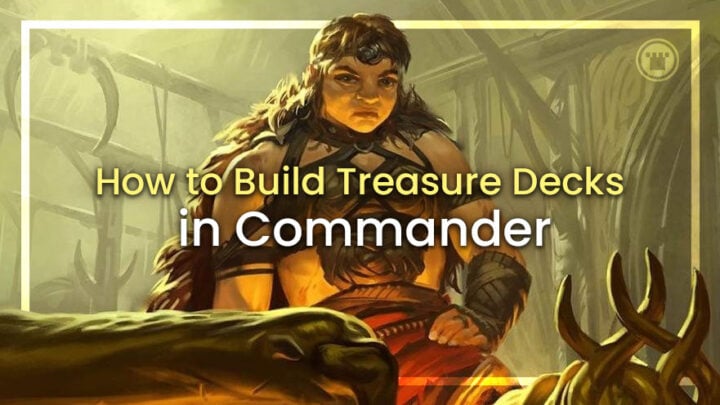It’s no secret treasures have been shaping the Commander landscape at all power levels for the past couple of years. In fact, it’s often unusual for a game of Commander to not feature at least a couple of treasure tokens. The count and quality of these cards have even become so great that treasures are the third most popular theme on EDHREC.
The first few treasure cards debuted during Ixalan block and were largely ignored, save for a few cards. At first they were seen as not much more than a flavorful mechanic to fit in with the pirates theme of the set, but as more treasure cards started showing up in new sets, attention started to shift towards them.
Yet, despite their humble beginnings and current ubiquity, what exactly is a treasure deck?
What Is A Treasure Deck?
Treasure decks want to use treasure tokens as their primary engine, utilizing one or more of their different aspects to their benefit. The three exploitable aspects of treasures are that they’re artifacts, they sacrifice themselves and they’re tokens.
These are three powerful archetypes by themselves, and treasure decks can make use of the best parts of each strategy. And this isn’t even taking into account the mana acceleration they offer, which can leave your opponents in the dust.
Building a Treasure Deck
Building a treasure deck can be tricky, especially considering how new the archetype is, but choosing the right commander can help you work toward a functional first draft in no time. Most treasure decks will have red in their color identity since it’s the color that has access to the most treasure cards.
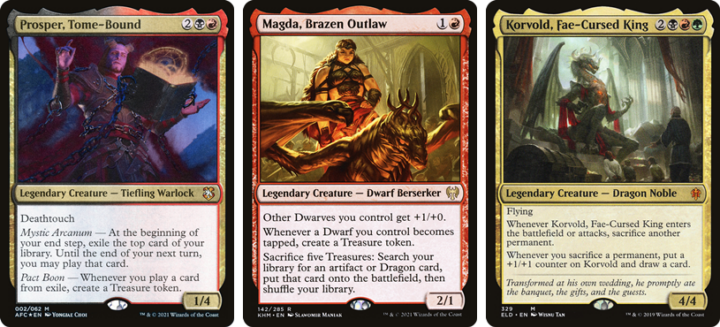
If you’re looking for high powered options, you’re spoiled for choices. Prosper is the most popular treasure commander, and for good reason. His abilities effectively give you an extra card per turn, and he will give you several treasures every turn when built correctly.
Magda, Brazen Outlaw is the second most popular treasure commander, as well as the second most powerful mono red commander ever. Her treasure generation is easy to abuse, and turning five treasures into a game-warping dragon is trivial to execute when building around the ability.
Korvold, Fae-Cursed King is infamous as a sacrifice commander, and one of the best commanders suited to really abuse the sacrifice aspect of treasures. When he’s on board, each treasure will draw you a card and increase his power, dramatically speeding up your clock.
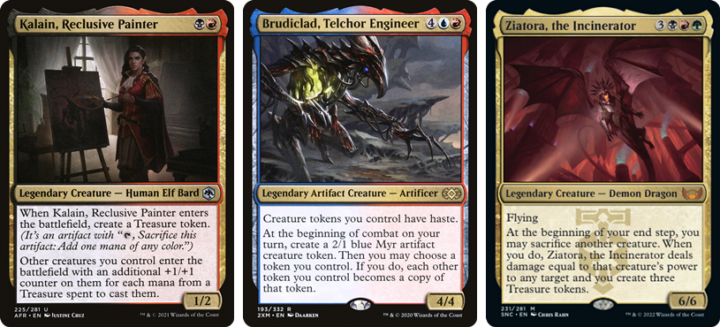
Lower power treasure commanders are also numerous and can be a blast to play with. Kalain, Reclusive Painter rewards you for playing creatures with treasures, which is one of the fairest uses for them. They also have a +1/+1 counters subtheme. That’s unusual in their color pairing, but it would make for an interesting take on both strategies.
Meanwhile, Brudiclad, Telchor Engineer has made a name for themselves as a bizarre yet enjoyable tokens and artifacts commander. As I mentioned earlier, those are two of the three main aspects to treasures.
Ziatora, the Incinerator may not be Korvold, but there’s a lot of room under the bar set by the dragon noble. Their sacrifice ability is much weaker than Korvold’s, but it’s a great way to generate treasures every turn. They’re also a lot less threatening than Korvold and thus much less likely to be the boogeyman at casual tables.
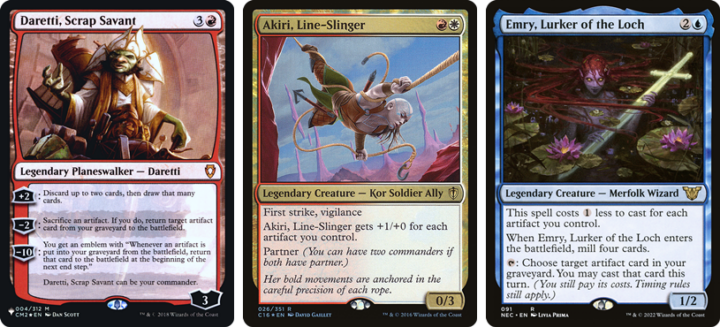
Basically any commander can benefit from an increase of treasure generation, but there are also some artifact or artifact-adjacent commanders who benefit more than most. Daretti, Scrap Savant can use treasures as reanimation fodder, Akiri, Line-Slinger grows bigger with every treasure and Emry, Lurker of the Loch can cheat on her commander tax with them.
These options may not be suitable as all-in treasure commanders, but they will still make exceptional use of treasures and the support cards I mention below.
Determining Power Level
Just like any other archetype, your card choices will influence the power level of your deck. There are a few cards synonymous with treasures that tend to impact a deck’s power level more than others, however.
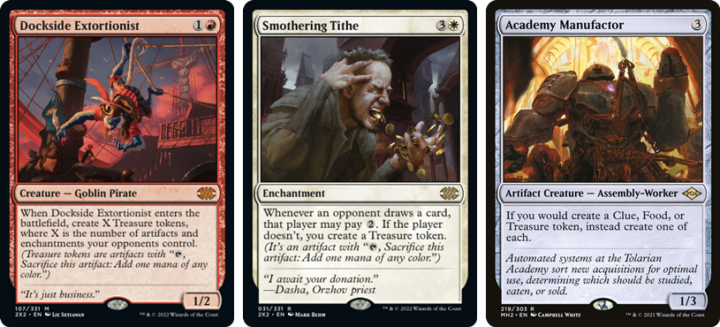
Dockside Extortionist, Smothering Tithe and Academy Manufactor are what I believe to be the three cards that fundamentally change the level at which a deck functions. Dockside can accelerate you far beyond reach in the right situation, Smothering Tithe can give you a steady stream of treasure over time and Academy Manufactor’s explosive value can warp a game beyond all recognition if left unchecked.
There are other cards that have a similar impact to these, like Xorn and Bootlegger’s Stash, but these pale in comparison to the fundamental change that these three have on a game.
The impact of these cards also increases with the consistency at which you can find them. Be sure you’re taking this into consideration when you’re building, especially if you play at more casual tables.
Treasure Generators
In order to build a treasure deck, you need to be able to make treasures! Some commanders may generate them, but they’re rarely enough by themselves. Here are some extra ways to make more money:
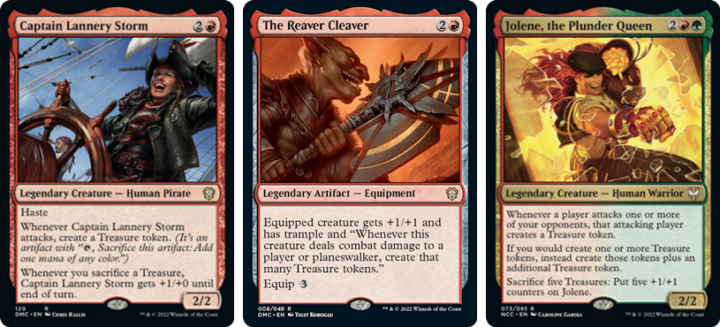
Treasure generators are separated into two groups: consistent and single use generators. Captain Lannery Storm is the classic, continuous generator. It may not seem like much at first, but an extra treasure per turn really adds up over time.
The Reaver Cleaver turns any creature into a mini “build-your-own-Old Gnawbone,” giving you a massive surge of treasure whenever the attacker connects with an opponent. It’s usually wise to ensure the creature makes it through, even spending some resources to do so, as the rewards can be game-altering.
Then there’s Jolene, the Plunder Queen who isn’t just a great treasure commander, but also a fantastic generator in her own right. Opponents are less likely to remove her compared to others since they can make use of her ability, but the asymmetrical effect will guarantee that you come out on top in every exchange.
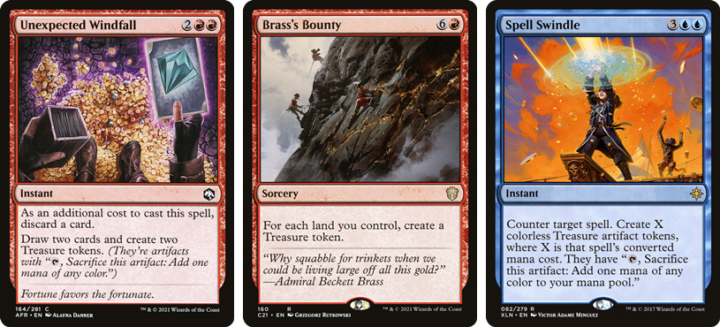
Single use generators are necessary to making sure your deck runs smoothly and can be critical in getting your engines online ahead of schedule. Unexpected Windfall and Big Score give you excellent card filtering, as well as a healthy boost of treasure. These are great for casting more expensive commanders sooner or for finding things to do with your extra mana.
There are few cards that cause as many wide-eyed expressions as Brass’s Bounty. It gives you a decent boost if you play it ahead of the curve thanks to an early Sol Ring or cost reducers, but in the late game this can be an instant win.
Spell Swindle is the treasure equivalent to Mana Drain. The mana cost may be significantly higher, but it rarely matters as you’re likely going to have mana to spare on any given turn.
Support Pieces
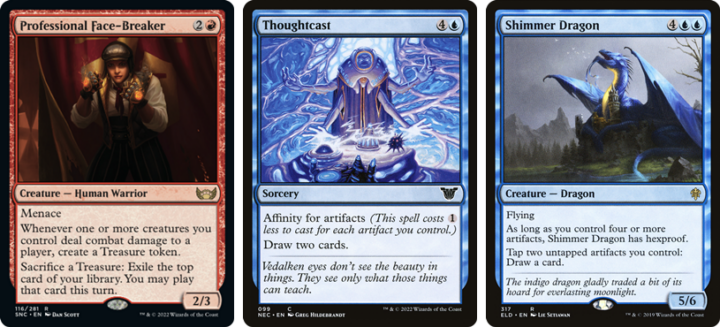
All decks need value engines to keep the cards flowing, and treasure decks have access to a lot of excellent options. Professional Face-Breaker lets you cash in a treasure for a card while also generating more on combat damage.
Artifact draw spells are at their best here — particularly anything with affinity for artifacts. Cards like Thoughtcast and Thought Monitor frequently cost just one mana and will help you draw into more gas.
Shimmer Dragon is a personal favorite of mine. Tapping two treasures to draw a card is extremely potent. It’s quite common to draw three or more cards per turn with this, and its conditional Hexproof is almost always online in these decks.

There are a few cards that synergize nicely with treasures to ensure you get the most out of every one of them. Ghirapur Aether Grid lets you weaponize them, turning your board of artifact tokens into repeatable removal and direct damage.
Mayhem Devil also really shines in treasure decks, turning every treasure into damage. It will also trigger from opponents’ permanents being sacrificed, so you can make those fetch lands even more painful.
Inspiring Statuary effectively converts each treasure into a colorless mana rock, but for nonartifact spells. If you thought treasures were powerful before, just think how much better they are when you don’t have to sacrifice them for mana!
Win Conditions
All good things must come to an end, and playing with treasure decks is no exception. The suite of win conditions you have access to when you’re playing with treasures is so varied. You can have multiple different angles of attack, so you can ensure success regardless of what you’re facing.
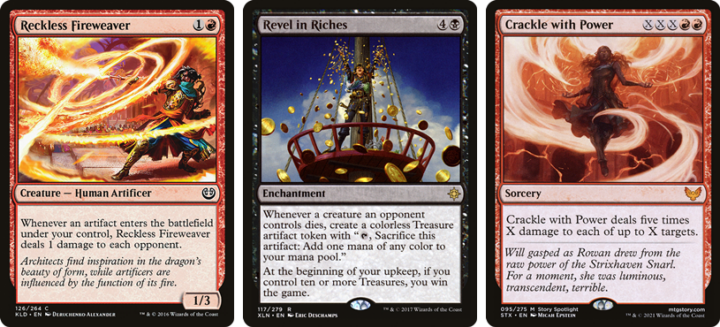
The most obvious win conditions are artifact payoffs like Reckless Fireweaver, Cranial Plating and Cyberdrive Awakener. These can come down early and start pressuring your opponents, forcing them to have an answer quickly. Since they scale with every artifact you make, they only get more dangerous as time goes on.
If you’d prefer an alternate win condition, you have Revel in Riches, Mechanized Production and Hellkite Tyrant. These all provide some incidental value before winning, but most importantly, they don’t require you to engage in combat. These are perfect against anything that would prevent a traditional kill, like Spore Frog locks or infinite life.
Considering you’re generating a lot of additional mana, you can always go for a tried and tested Torment of Hailfire or Crackle with Power. Even at a lower power level, you can gain extra style points by casting the classic Fireball for the win.
End Step
Treasure decks may not be for everyone, but they appeal in different ways many players love. If they’re your kind of thing, the good news is they’re probably here to stay. Recent card design indicates we’ll likely continue to see them pop up in most sets, in some form.
However, if they’re not for you and you want to try and fight treasure heavy decks, you can take a look at my piece on tackling treasures in Commander for some ideas.
Otherwise, if this helped you to build a treasure deck or you have one that you enjoy playing with already, tag me in a post about them on Twitter. I’d love to see them!

Scott is an Irish content creator and the Head of Budget Magic for the Izzet League. He focuses on affordable decks in Pioneer, Modern, and Pauper, particularly ones that stray from the mainstream. When he’s not writing about his favorite decks, he can be found talking incessantly about them on Twitter and on The Budget Magic Cast.

